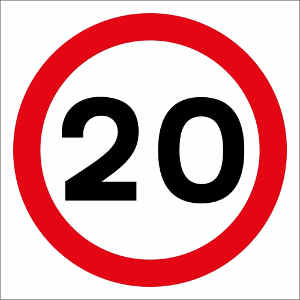Government Announces Reversion Of 20mph Speed Limits.

In a significant move set to commence in September 2024, the Welsh Government under Transport Secretary Ken Skates is rolling back some newly implemented 20mph speed limits to their original 30mph designation. Skates urges locals to engage with their respective local councils to provide input on areas where these adjustments should take effect.
While concrete figures on the number of roads affected remain unavailable, government officials acknowledge challenges with the widespread implementation of 20mph limits since their inception. Mainly, built-up areas have seen heightened public discontent regarding these speed restrictions.
Notably, Plaid Cymru will cover the associated costs of all roads reverting to their former speed limits rather than placing the burden on local councils.
Plaid Cymru has called for a wider Government debate on the topic of 20 mph speed limits following the news. Leader Rhun ap Iorwerth said: “We know that the UK Conservative Government wants to put a stranglehold on Wales’s finances and have been intent on keeping Wales in the slow lane by not re-designating HS2 an England-only project.”
Understanding speed limits is pivotal for private and motor trade motorists navigating UK roads.
Historically, speed limits date back to the Locomotives on Highways Act of 1861, which initially restricted vehicles to 10mph. The Locomotive Act of 1865 reduced the limit to 4mph in rural areas and a mere two mph in urban settings. Today, UK speed limits generally stand at 30mph in urban locales, 60mph on main single-carriageway roads, and 70mph on dual-carriageways and motorways.
However, vehicle types often influence permissible speeds. For instance, most vans are limited to 60mph on dual carriageways and 50mph on single carriageways, while caravans are restricted to 30mph in built-up areas.
Importantly, speed limits should be regarded as maximums, not targets. Exceeding these limits can result in fines starting at £100 and penalty points on one’s licence, potentially leading to disqualification for repeat offenders and difficult conversations with your insurance broker about your insurance policy.
Road signs play a crucial role in indicating speed limits. Fixed limits, identified by numbers within red circles, are predominant, with variable limits emerging in smart motorway contexts. These dynamic limits, displayed on gantries, adapt to traffic flow to enhance safety and mitigate congestion.

Moreover, although rare, minimum speed limits exist where slow speeds can pose hazards, such as in tunnels. Failure to adhere to minimum speeds may attract police attention and potential penalties.
As the Welsh Government navigates speed limit adjustments, it underscores the importance of public engagement and adherence to established regulations for safer, more efficient road usage.
Ken Skates, Cabinet Secretary for Transport in Wales, said: “The Welsh government continues to believe that 20mph is the correct speed limit in places such as near schools, hospitals, nurseries, community centres, play areas and in built-up residential areas.
“What I am doing now is listening to what people want for the roads in their communities and pressing ahead with refining the policy and getting the right speed on the right roads.”







